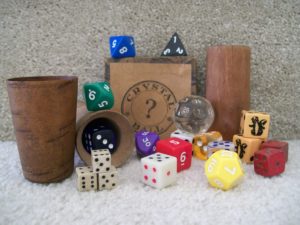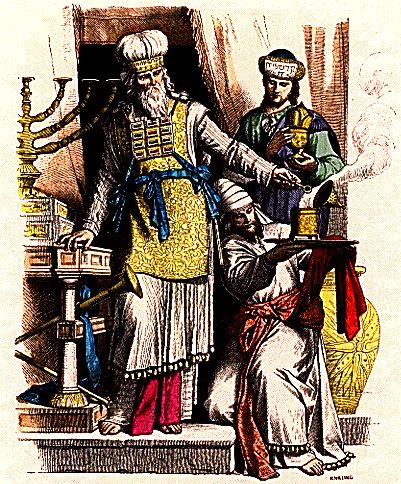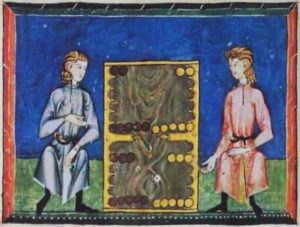
I realize many people probably don’t think much about the history of Dice, but it is actually quite interesting. Especially since some of the first Dice relate to two mysterious things mentioned in the Bible that were believed to reveal the Will of God. How incredible that would be! But more on those sacred objects, known as the Urim and Thummim, soon.
Many different forms of dice have been found in excavations across the world, written about in ancient texts, and seen in beautiful artwork of the past. They are an interesting part of human history and culture. Their integration into the lives of people, in a variety of ways, from divination to gambling is intriguing to note.
Although the origins of Dice are not completely certain and lost to time, Plato expresses an Egyptian origin in Phaedrus 274d. He states;
“The name of that divinity was Thoth, and it was he who first discovered number and calculation, geometry and astronomy, as well as the games of checkers and dice, and, above all else, writing.”
The oldest known cubical dice found date to around 2800BC, almost 5000 years ago. These were part of a board game similar to that of Backgammon and were excavated in 2004 in Burnt City, Iran. Dating back almost as far, tetrahedral dice and other styles have been unearthed in the royal graves at Ur and in Egypt. As more excavations are made older dice may appear which could verify Plato’s account. Nevertheless, whatever their origin, it is clear dice were an active part of life all across the globe.
The source of the word Dice traces to the Latin word, datum, which holds the meaning of ‘something given or played’. Dice, today, are often just implements of chance and are produced in many shapes and sizes. From the sphere to even the one hundred sided. But research has found the rolls of Dice were not always thought of as random and that one of the earliest uses of Dice was for divination. From this it can be recognized how Dice resonates with ‘something was given’ and so named.
What is Cleromancy?
When the casting of lots (another term for tossing dice) is employed and believed to be more than mere chance, it is called cleromancy. Some of the first written examples of cleromancy or divination are found within the verses of the Old Testament in the Christian Bible. Here the outcome of the die cast is believed to be determined, not by chance, but by divine intervention from God. Proverbs 16:33 states:
“The lot is cast into the lap, but its every decision is from the Lord.”
The Urim and Thummim

Another example is found in Exodus 28:30. This verse mentions the name of two peculiar objects; those mysterious things called the Urim and the Thummim. It is written they are the “means of making decisions.” Many feel these could be an early form of sacred dice or used in such a way as dice.
A clear description of exactly what they were or what they were made from is not given. Some believe they were precious stones and were relatively small since it is known they were placed within the sacred breastplate worn by the high priest.
Exodus 28:30: “You are to put the Urim and the Thummim into the breastpiece of decision (or judgment); and they are to be over Aaron’s heart when he goes in before the Lord. Aaron is to bear the decisions of the Israelites over his heart before the Lord continually.”
Another verse in the Bible offers a glimpse into how they were used:
Samuel 1, 14:41: “Then Saul asked the Lord God of Israel, “Why haven’t you answered your servant today? If the wrongdoing is mine or my son Jonathan’s, respond with Urim, but if the wrongdoing belongs to your people Israel, respond with Thummim.” Jonathan and Saul were taken by lot, and the troops were cleared.
The words Urim and Thummim relate to Revelation and Truth. Many of the examples given in the Bible for these mysterious things being brought out of the breastplate to be in service suggest they offered Yes or No answers. Much like odds or evens on dice rolls can represent ‘yes or no’.
No matter what they were the Urim and Thummim were then lost to history. There isn’t mention of their use after it seems the time of Babylonian captivity around 550-600 BC. Wouldn’t it be awesome to someday excavate either the items themselves or additional records about them?
The practice of casting lots or dice for revealing the will of God or other spiritual powers most likely led people to then begin placing bets upon those results. Human nature took over, and so the widespread use of dice for gambling evolved.
From this practice, casting of lots became more of a routine, and overtime, they lost their sacredness. Instead of invoking the will of God over only important matters, they were used to make everyday decisions. This caused the loss of them to be seen as something special and divine in nature.
Knucklebones
As civilizations developed, allowing more time for leisurely pursuits, board games were created and played. Many required dice or instruments of chance to decide movements for the players. These movements were often thought to have a Divine Guidance in earliest play. Even today, the rolls are still sometimes believed by many to be influenced by a higher power.
Dice were constructed from different materials and depending on what was used often decided the amount of sides. Some forms of dice were simply binary and made from staves. These pieces of wood were fashioned in a way so one side was flat, the other curved. Adding more staves offered a greater number to be given and applied. A beautiful set of 5 throwing sticks was discovered in King Tutankhamen’s tomb as part of the board game called Senet. One of the oldest games known.
Another popular material used, which turned into the name of a game itself, was the knucklebone (astragal) of a sheep or goat. These bone dice offered 4 possible resting sides when thrown. In the Myth where Zeus divides the universe with his brother, they cast knucklebones to give the answer. Throughout the ages, people have also used walnut shells, beleric nuts, teeth, stones, seeds, and shells for casting too.
Alfonso Manuscript on Dice

From written sources like the Bible, the Mahabharata, or the Buddha’s Game List mentioning dice within their passages, information about the history of dice or lots can be surmised. The Alfonso manuscript, written in 1283 AD specifically discusses dice.
This manuscript is a prized piece of work for studying dice and the games of this time period. The manuscript informs the reader of an opinion on how dice should be constructed. It states the best dice are made from bone because its weight can be equally distributed. This allows the dice to roll honestly and not to land more on one side than another.
Cheating with crooked dice or trickery is warned against, and one of the illustrations within the manuscript displays the consequences of losing to the rolls of dice. It shows an empty money bag and the players are not completely dressed. It seems they have wagered even their clothes. They have lost their shirts right off their backs.
Artwork often depicts players of board and dice games. One popular example is a piece of pottery showing Achilles and Ajax playing a dice game, seen right.
Collecting Dice
Dice during the ages have had many variants and make for interesting collections. There are some collections with over 1000’s of different dice. A collection could compose of the following.
Different shapes (ex. Platonic solids)
Different sizes (ex. small to large)
Different material (ex. bone, ivory, silver, wood)
Different numbering schemes (ex. Instead of the standard 1 opposite 6,2 opposite 5,3 opposite 4, some dice are 1 opposite 2, 3 and 4,5 and 6)
Different colors (ex. Rainbow collection)
Different symbols on the faces (ex. Letters instead of numbers)
Different types (ex. Casino dice, loaded dice)
And so on. Any large collection would share the interesting changes and history dice have gone through. A collection may even include indicators (spinners) because they had replaced dice for a short time for board games in the 1800’s, since dice were associated with gambling and unworthy to use at that stage.
As instruments used for insight, choice or decision making, dice will continue to be tossed into the future. They have their own destiny to fulfill.

Interesting stuff. Once again I have to wonder where it all began.
The antiquity of humanity is probably the most fascinating subject of all.